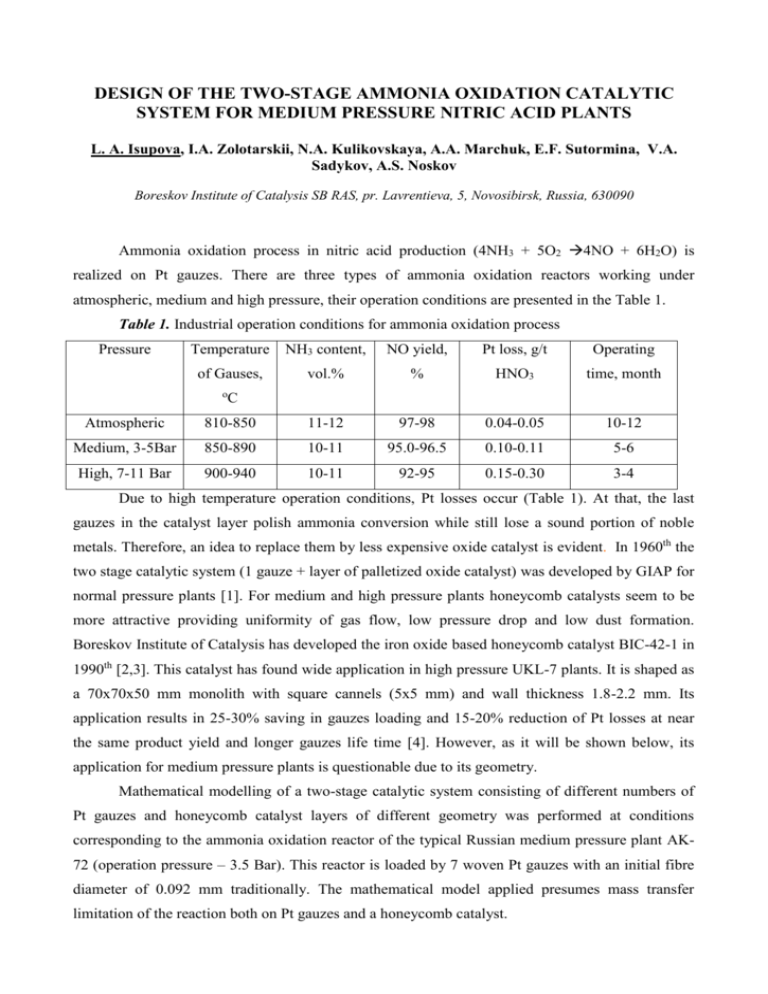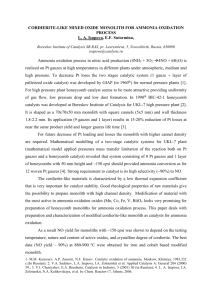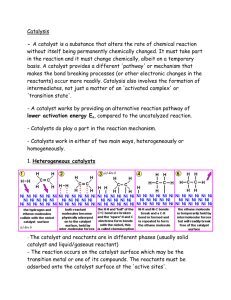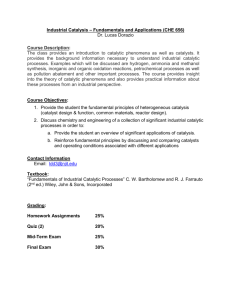design of the two-stage ammonia oxidation catalytic system for
advertisement

DESIGN OF THE TWO-STAGE AMMONIA OXIDATION CATALYTIC SYSTEM FOR MEDIUM PRESSURE NITRIC ACID PLANTS L. A. Isupova, I.A. Zolotarskii, N.A. Kulikovskaya, A.A. Marchuk, E.F. Sutormina, V.A. Sadykov, A.S. Noskov Boreskov Institute of Catalysis SB RAS, pr. Lavrentieva, 5, Novosibirsk, Russia, 630090 Ammonia oxidation process in nitric acid production (4NH3 + 5O2 4NO + 6H2O) is realized on Pt gauzes. There are three types of ammonia oxidation reactors working under atmospheric, medium and high pressure, their operation conditions are presented in the Table 1. Table 1. Industrial operation conditions for ammonia oxidation process Pressure Temperature NH3 content, NO yield, Pt loss, g/t Operating of Gauses, vol.% % HNO3 time, month o C Atmospheric 810-850 11-12 97-98 0.04-0.05 10-12 Medium, 3-5Bar 850-890 10-11 95.0-96.5 0.10-0.11 5-6 High, 7-11 Bar 900-940 10-11 92-95 0.15-0.30 3-4 Due to high temperature operation conditions, Pt losses occur (Table 1). At that, the last gauzes in the catalyst layer polish ammonia conversion while still lose a sound portion of noble metals. Therefore, an idea to replace them by less expensive oxide catalyst is evident. In 1960th the two stage catalytic system (1 gauze + layer of palletized oxide catalyst) was developed by GIAP for normal pressure plants [1]. For medium and high pressure plants honeycomb catalysts seem to be more attractive providing uniformity of gas flow, low pressure drop and low dust formation. Boreskov Institute of Catalysis has developed the iron oxide based honeycomb catalyst BIC-42-1 in 1990th [2,3]. This catalyst has found wide application in high pressure UKL-7 plants. It is shaped as a 70x70x50 mm monolith with square cannels (5x5 mm) and wall thickness 1.8-2.2 mm. Its application results in 25-30% saving in gauzes loading and 15-20% reduction of Pt losses at near the same product yield and longer gauzes life time [4]. However, as it will be shown below, its application for medium pressure plants is questionable due to its geometry. Mathematical modelling of a two-stage catalytic system consisting of different numbers of Pt gauzes and honeycomb catalyst layers of different geometry was performed at conditions corresponding to the ammonia oxidation reactor of the typical Russian medium pressure plant AK72 (operation pressure – 3.5 Bar). This reactor is loaded by 7 woven Pt gauzes with an initial fibre diameter of 0.092 mm traditionally. The mathematical model applied presumes mass transfer limitation of the reaction both on Pt gauzes and a honeycomb catalyst. Calculations show that ammonia conversion reaches 98.8% when a standard catalytic system with 7 sheets is used. The aim of calculations was to find out a configuration of a honeycomb catalyst bed when 3 sheets of Pt gauzes are removed. Table 2 shows calculation results for 3 types of a honeycomb catalyst. Table 2. Ammonia conversion for different configuration of a honeycomb catalyst bed. Number of channels per square inch: I – 15, II – 30, III – 200. Height of one layer – 50 mm. Number of honeycomb catalyst layers Type of catalyst 1 2 3 I 96.9 98.1 98.8 II 97.7 99.0 99.6 III 98.6 99.6 99.9 One can see that a two-stage catalytic system comprising 4 Pt gauzes and 2 layers of the catalyst III or 3 layers of the catalyst II provides ammonia conversion higher than a standard Pt system. Such system can be applied in industry if the oxide honeycomb catalyst meets the following requirements: - high activity; - high selectivity; - robustness in operation conditions (strength and resistance to thermoshocks); - manufacturability. It is hardly possible to fulfill these requirements, especially thermoshock resistance, for a bulk iron oxide based honeycomb monolith catalyst with cell density corresponding to catalyst II and III because of its rather high thermal expansion coefficient (TEC). Therefore, a comprehensive study of different catalytic materials was carried out. The frame structured cordierite (2MgOx2Al2O3x5SiO2) honeycombs are characterized by the low TEC (2*10-6 1/K) and often used as a refractory carrier for high temperature catalyst applications [5]. Results of this study for impregnated on cordierite catalyst including results of a life test in real operation conditions were published in [ 6 ]. . This paper presents results of ammonia oxidation process study for another kind of catalytic materials - cordierite-like frame structured ones. A frame structure allows to obtain modified materials with 3d active cations (Fe, Co, Mn) instead of Mg, that may be active in ammonia oxidation. Meanwhile frame structured materials can be directly shaped as monoliths. Therefore, this paper deals with investigation of ammonia oxidation process with modified frame structured honeycomb monoliths. A draw plate used for monoliths preparation had a triangle channel side of 2.5 mm and wall thickness of 0.4 mm that gives approximately 200 channels per square inch. Monolith height was 50 mm. Three types of honeycomb catalysts with Co, Fe and Mn cations (2CoOx2Al2O3x5SiO2, 2FeOx2Al2O3x5SiO2, MnOx2Al2O3x5SiO2) were prepared. Ammonia oxidation process was carried out in a bench scale quartz tubular reactor with inner diameter of 26 mm at temperature 700-900 oC and atmospheric pressure. Samples of honeycomb catalysts in the form of fragments with diameter of 21-22 mm and length of 50 mm were tested with and without one Pt sheet. Before the reaction starts up, catalysts were preheated at 700 oC in air for 30 minutes. Then reaction gazes (5% ammonia in the air preheated at 450oC in a quartz mixer) were flowed through the catalyst with 7.6 l/min flow rate (standard gas velocity 0.33 m/s). The ignition of the catalyst was determined by temperature increase. Ammonia, NO and NO2 concentrations were analyzed by the on-line spectrophotometer analysis [6, 7]. All such prepared catalysts provide 100 % ammonia conversion degree even without Pt gauzes at temperature higher 850 oC. The two-stage system (with one Pt gauze) provides NO yield higher than 94%. 2FeOx2Al2O3x5SiO2 and MnOx2Al2O3x5SiO2 frame structured catalysts (BIC42-4) was shown not to be deactivated after living tests in UKL-7 plant as compared with supported catalysts. REFERENCES 1. M.M. Karavaev, A.P. Zasorin, N.F. Klesev. Catalytic oxidation of ammonia. Moskow, Khimiya, 1983.232 c.(In Russian) 2. V.A. Sadykov, E.A. Brushtein, L.A. Isupova, et al. Khimicheskaya promyshlennost’, No 12 (1997) 33 (In Russian). 3. V.A. Sadykov, L.A. Isupova, I.A. Zolotarskii et al. Applied Catalysis A: General 204 (2000) 59. 4. V.I. Chernyshev, E.A. Brushtein, Cataliz v Promyshlennosti (Catalysis in Industry), 3 (2001) 30 (in Russian). 5. E.G. Avakumov, A.A. Gusev. Kordierite- advanced ceramic material. Novosibirsk, SB RAS, 1999 166c 6. L. A. Isupova, E.F. Sutormina, N.A. Kulikovskaya, L.M. Plyasova, N.A.Rudina, I.A. Ovsyannikova, I.A. Zolotarskii, V.A. Sadykov Catalysis.Today105(2005) 436. 7. Е. F. Sutormina, Zurnal Analiticheskoi Khimii (J. Analytic Chem.) 59/4 (2004) 1 (In Russian).







